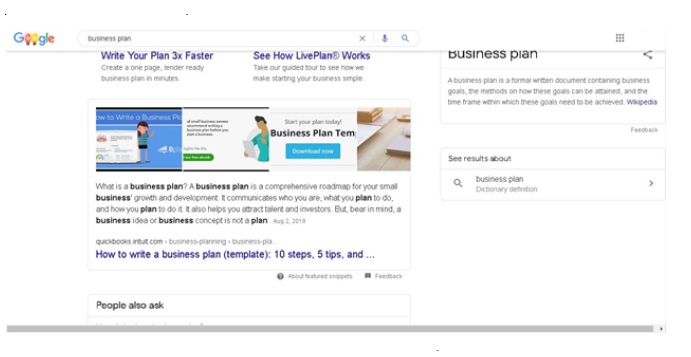Getting your website to rank well can be easier said than done. There’s so much competition for the top-ranking snippets and many possible tricks to improve your SERP.


Getting your website to rank well can be easier said than done. There’s so much competition for the top-ranking snippets and many possible tricks to improve your SERP. Ask ten webmasters, and you’ll get ten different answers about what works best.
They’re all good ideas until a search engine algorithm update sends your page plummeting to obscurity. That’s why, in this post, we’re not giving you a long list of SEO tips. Instead, we’ll look at featured snippets and how you can get them.
These are informational content that Google deems best suited for the search term. It gives an overview of what the word means and other information that Google considers relevant.
The information appears in a box just under the sponsored results in what is known as the zero position. You’ll see an example in the screenshot below.

When Google first trialed this feature, it placed the snippet at the top of the page and your page description in the search results. However, this has been changed—if Google uses a snippet from your page, your link only appears under the snippet, not within the results.
This change caused a furious debate. Some believed that it was better to ignore the snippet and focus on the search results. Others felt that the position of the snippet gave them an advantage.
According to Ahrefs’s research, both groups make a good point. Ahrefs studied millions of search results and found that featured snippets garnered around 8.6% of clicks in the top position. By contrast, the top web result below it got 19.6% of clicks.
It would appear that the snippet doesn’t give you much of an advantage until you read the remaining research. When no snippets are present, the top result gets an average of 26% of clicks. The snippet, therefore, draws clicks away from the top result.
Interestingly, clickthrough rates, when snippets were present, dropped by 4% across the board. This makes sense because it means that the person got the answer they needed by reading the snippet.
These little bits of information seem to bode ill for snippets until you look at them differently. According to Search Engine Journal, the top three search results get 55.2% of the clicks. If you’re in the tenth position on that list, your CTR will drop to around 2.5%.
Having Google feature content from your website can thus give you an advantage over higher-ranking sites.
Towards the end of November 2020, SEO experts noticed an alarming change in featured snippets. It seemed that Google was trialing AI-created snippets and drawing the information from several sources. It created hyperlinks to different sources within one passage.
Needless to say, this tactic diluted the traffic for webmasters as not one site gained the credit for the information. Google has since removed this “enhancement” and reverted to using just one source. It has confirmed that the trial was unsuccessful and won’t be implemented full-time.
Using a free tool such as SERP Checker will allow you to see how your website currently ranks for your search terms. Check back every two weeks or so and recheck your ranking. By comparing your progress against each preceding benchmark, you’ll be able to see what works and what doesn’t in your niche.
The Google Keyword Planner is free and allows you to see how specific keywords rank. You may also analyze a particular URL and see what keywords are used. The tool isn’t perfect, but it will generate a list of potential keywords for you to target.
You may also use it to see what keywords your competitors have targeted.
Google aims to provide its users with access to the most useful information. An excellent way to get a snippet featured is to create questions around your keywords. Use your FAQ page to your advantage here.
Set up each question, then Google it. Look at the snippet already there and see how you can improve the answer given. Can you provide a more in-depth explanation? Take time to create a flawless response to the question that’s better than anything else out there.
Like any other form of content marketing, it’ll take a little time for Google to find and feature your content.
When researching your questions, look for those most commonly asked. Build up extra content around those questions specifically. The most common questions start with:
Create a blog post surrounding these questions and work out long-tailed keywords to include in your content. Use a broad question to start off with, for example, “How to build a desk.” Then use more in-depth questions in your text. You could, for example, include questions like, “How to draft a desk design,” “Why do I need to measure my desk components carefully?” and “How to finish off a home-made desk.”
If you need inspiration, type your main question into Google and then look at the box with the questions people ask. Also, look at the bottom of the page for related queries.
It’s also a good idea to check sites such as Quora and Answer the Public to find out what questions people ask.
Finally, check your competitors’ websites and see what types of questions they’ve asked and answered.
Start your post with the question, and give a short answer straight away. Stick to around fifty words of content here. You’ll answer the question in greater depth in the post. This allows Google to create the snippet easily.
By breaking your content up in this manner, you highlight the critical parts. Your post might not rank for the main topic, but if there’s one section that’s not been extensively covered, it could rank for that.
Aim for long-form and flawlessly written content. You can write a short blogpost of 300 words, but how much detail can you put into it? Search engines look for content that will best answer the question.
Consider creating content of at least 1,500 words to stand the best chance of being featured. Look at the top-ranking content on the subject and see what you can do to improve upon it.
Are there questions that are not answered? Can you delve deeper into the subject? Can you create a piece that helps complete beginners understand the topic thoroughly?
When you’ve worked out the basic outline, create great content. To rank well, it must be:
Now make your content even better with images, screenshots, videos, and infographics where possible. You can quickly put pictures together with free editing software like Canva.
Work on creating a page that keeps your users glued to the page. Consider placing tweetable statistics that your users can easily share.
Think quality over quantity. Creating one piece of great content will stand you a better chance of being featured than having numerous half-complete pages.
These work slightly differently to the FAQ but also answer a question that a visitor might ask. Keep the tutorial concise and ensure that it has real value to the reader.
Back up facts by linking through to authoritative websites. This demonstrates to the search engines that the piece is well-researched. It also allows visitors to confirm the facts for themselves, and this builds trust in your website.
Also, consider linking out to pages that contain more detailed information on a specific topic within the post. Ideally, you should link to other pages on your blog, but you may also link out to interesting articles you’ve read or other informative bloggers.
Featured snippets can help you rank above competitors with far larger marketing budgets than your own. The key to convincing Google to place your content in position zero is making it irresistible. Ensure that it’s exquisitely crafted and that it’s flawless.
Add interest with images, extra resources, and information no one else has. Work toward creating the ultimate resource. It will mean a lot of extra work initially, but it’ll also ensure that you have evergreen content that will attract organic traffic for many years.






